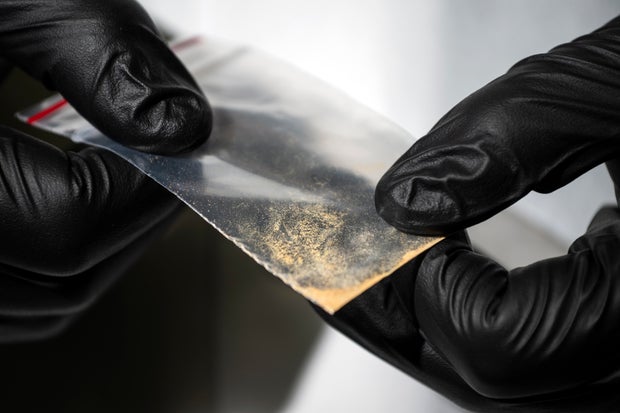[ad_1]
London — As authorities clamp down on fentanyl distribution and the amount of heroin produced in Afghanistan decreases under the Taliban, criminal enterprises have turned to a deadly alternative. Some health agencies in Europe are reporting a rise in deaths and overdoses from a type of synthetic opioid that can reportedly be hundreds of times stronger than heroin and up to forty times stronger than fentanyl.
2-Benzyl Benzimidazole opioids, commonly known as nitazines, are a class of synthetic compound developed in the 1950s as painkillers, but which were never approved for use as medicines.
Because of their potency, compared with natural opioids such as heroin or morphine, they can be much more addictive and more dangerous. Nitazines have been linked to a significantly greater proportion of overdose deaths in Estonia and Lithuania, and have been linked to overdoses in Ireland and on the French island of La Réunion.
Rising use of the drugs has also been noted in the U.S., where they’ve been dubbed “Frankenstein opioids,” in recent years, and they have been labelled a public health concern by the Drug Enforcement Administration.
Joe Lamberti for The Washington Post/Getty
“Nitazenes pose a credible threat and… predicted changes in heroin availability in Europe could herald an increase in the use of synthetic opioids with possibly profound implications for public health,” the European Monitoring Centre for Drugs and Drug Addiction wrote in a letter to the Lancet public health journal in February. “We cannot assume that existing approaches to responding to opioid problems will be sufficient without adapting to the challenges posed by the appearance of a range of highly potent but pharmacologically diverse substances.”
On Wednesday, the U.K. government announced that it was classifying 14 nitazenes as Class A drugs, meaning they will be placed under the strictest controls alongside fentanyl, “to prevent drug related deaths in the U.K. and ensure anyone caught supplying these substances faces tough penalties.”
“Synthetic opioids are significantly more toxic than heroin and have led to thousands of deaths overseas,” Britain’s Crime and Policing Minister Chris Philp said in a statement. “We are determined to ensure these destructive and lethal drugs do not take hold in our communities in the U.K.”
Dr. Adam Holland, a drug researcher at England’s Bristol University, wrote a commentary piece in the Lancet in January saying nitazenes had been detected in other drugs being sold as other opioids, along with benzodiazepines and cannabis products, meaning users may not be aware of the risks they face.
Holland said the gap in the European heroin market created by the Taliban’s crackdown on production in Afghanistan could lead to a boom in nitazenes across Europe.
“Without concerted action, nitazenes could devastate communities of people who use a range of drugs, including those who use drugs infrequently or source benzodiazepines and opioid painkillers from the internet,” Holland warned.
[ad_2]
Source link








